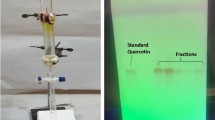Abstract
This study was designed to determine the trypsin inhibitory potential of rutin (1) and its biotransformed metabolite, quercetin (2). Rutin (1) was purified from the methanolic extract of Citrus sinensis and biotransformed in the culture of Streptomyces griseus, which yielded quercetin (2) as the major product. Both 1 and 2 showed significant trypsin inhibitory potential with IC50 = 0.016 ± 0.002 and 0.019 ± 0.003 mM, respectively. Kinetic studies were carried out using GraFit 7.0 software. Lineweaver–Burk and Dixon plots and their secondary replots indicated that these compounds are non-competitive inhibitors. The K i values of 1 and 2 were found to be 17.5 ± 0.7 and 3.1 ± 0.5 μM, respectively.



Similar content being viewed by others
References
Asres K, Seyoum A, Veeresham C, Bucar F, Gibbons S (2005) Naturally derived anti-HIV agents. Phytother Res 19:557–581
Betts RE, Walters DE, Rosazza JP (1974) Microbial transformation of natural antitumor agents. I. Conversion of acronycine to 9-hydroxyacronycine by Cunninghamella echinulata. J Med Chem 17:599–602
Borrelli F, Izz AA (2000) The plant kingdom as a source of anti-ulcer remedies. Phytother Res 14:581–591
Chan S, Yuan-Shiun C, Jih-Pyang W, Sheng-Chih C, Sheng-Chu K (1998) Three new flavonoids and antiallergic, anti-inflammatory constituents from the heartwood of Dalbergia odorifera. Planta Med 64:153–158
Dixon M (1953) The determination of enzyme inhibitor constants. Biochem J 5:170–171
Fatemeh F, Abbas D, Roya A, Satyajit DS (2006) Extraction of flavonoids and quantification of rutin from waste tobacco leaves. J Pharm Res 3:222–227
Giovanni A, David PF (2005) Protease inhibitors in the clinic. Med Chem 1:71–104
Jedinák A, Maliar T, Cai GD, Nagy M (2006) Inhibition activities of natural products on serine proteases. Phytother Res 20:214–217
Jones DT (1995) Rutaceae in tree flora of Sabah and Sarawak vol. 1. In: Soepadmo E, Wong KM (eds) FRIM, FD Sabah and FD Sarawak. Ampang Press, Kuala Lumpur, pp 351–419
Kim HP, Son KH, Chang HW, Kang SS (2004) Anti-inflammatory plant flavonoids and cellular action mechanisms. J Pharmacol Sci 96:229–245
Leatherbarrow RJ (2010) GraFit version 7.0. Erithacus Software Ltd., Staines
Long Y, Sheau-Ling L, Chen-Yong L, Istvan JE, Shaomeng W, Peng L, Robert BD, Peter PR (2001) Synthesis and evaluation of the sunflower derived trypsin inhibitor as a potent inhibitor of the type II transmembrane serine protease, matriptase. Bioorg Med Chem Lett 11:2525–2529
Maliar T, Jedinák A, Kadrabová J, Šturdík E (2004) Structural aspects of flavonoids as trypsin inhibitors. Eur J Med Chem 39:241–248
Nicolas F, Isabelle R (2001) Determination of flavone, flavonol, and flavanone aglycones by negative ion liquid chromatography electrospray ion trap mass spectrometry. Am Soc Mass Spectrometr 12:707–715
Nijveldt RJ, Els VN, Danny EVAH, Petra GB, Klaske VN, Paul AVL (2001) Flavonoids: a review of probable mechanisms of action and potential applications. Am J Clin Nutr 74:418–425
Parellada J, Guinea M (1995) Flavonoid inhibitors of trypsin and leucine aminopeptidase: a proposed mathematical model for IC50 estimation. J Nat Prod 58:823–829
Peter RS, John AL (1997) Plant proteins that confer resistance to pests and pathogens. Adv Bot Res 26:135–170
Shahwar D, Raza MA, Shafiq UR, Khan T (2011a) Evaluation of acetylcholine esterase and protease inhibitory activity of scopolamine extracted from Datura innoxia. Asian J Chem 23:1783–1785
Shahwar D, Raza MA, Ali T, Viqar UA (2011b) Microbial transformation of vanillin isolated from Melia azedarach to vanillyl alcohol followed by protease inhibition and antioxidant activity. J Chem Soc Pak 33:715–719
Shahwar D, Raza MA, Shafiq UR, Muhammad AA, Atta-Ur-Rahman (2012a) An investigation of phenolic compounds from plant sources as trypsin inhibitors. Nat Prod Res 26(12):1087–1093
Shahwar D, Raza MA, Khan T (2012b) Synthesis and evaluation of enzyme inhibitory potential of some derivatives of scopolamine. Turk J Chem 36:257–266
Acknowledgments
The authors are grateful to Higher Education Commission of Pakistan for providing funds under Indigenous Scholarship Scheme (042-111212-200-PS2-200).
Author information
Authors and Affiliations
Corresponding author
Rights and permissions
About this article
Cite this article
Raza, M.A., Shahwar, D. Trypsin inhibitory potential and microbial transformation of rutin isolated from Citrus sinensis . Med Chem Res 22, 3698–3702 (2013). https://doi.org/10.1007/s00044-012-0379-1
Received:
Accepted:
Published:
Issue Date:
DOI: https://doi.org/10.1007/s00044-012-0379-1




